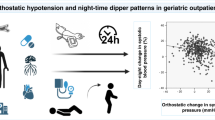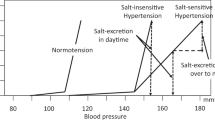Abstract
Previous studies have reported a significant relationship between hypertension and nocturia. However, the underlying pathophysiology associated with pulse rate (PR) remains unclear. In the Japan Morning Surge-Home Blood Pressure Study, a self-administered nocturia questionnaire and evening home blood pressure (BP) and PR measurements (taken on a mean of 11.2 days) were performed on 4310 patients with one or more cardiovascular risk factors (mean: 64.9 years old; 47% male). According to the number of nighttime voids, the study population was divided into three groups (no voids: n = 2382; 1 void: n = 847; ≥2 voids per night: n = 1082). In the multinomial logistic regression analysis adjusted for confounders, diuretic use (OR, 1.23; 95%CI, 1.01–1.50; p < 0.05) was significantly associated with one nocturnal void, whereas evening home systolic BP (SBP) (OR per 1 SD, 1.14; 95%CI, 1.05–1.24; p < 0.01) and evening home PR (OR per 1 SD, 1.12; 95%CI: 1.02–1.24; p < 0.05) were significantly associated with multiple nocturnal voids. In the younger group (<65 years), only evening home PR was significantly related to multiple nighttime voids (p < 0.01), whereas in the older group (≥65 years), only evening home SBP was significantly related to multiple nighttime voids (p = 0.02). In this study, both higher evening home PR and higher evening home SBP were associated with multiple nighttime voids, with the former playing a greater role in the younger participants, and the latter more often associating the older group. An age-stratified approach to reduce the burden of BP or PR might be important to improve sleep quality.
This is a preview of subscription content, access via your institution
Access options
Subscribe to this journal
Receive 12 digital issues and online access to articles
$119.00 per year
only $9.92 per issue
Buy this article
- Purchase on Springer Link
- Instant access to full article PDF
Prices may be subject to local taxes which are calculated during checkout

Similar content being viewed by others
Data availability
The data that support the findings of this study are available from the corresponding author upon reasonable request.
References
Feldstein CA. Nocturia in arterial hypertension: a prevalent, underreported, and sometimes underestimated association. J Am Soc Hypertens. 2013;7:75–84.
Tikkinen KA, Johnson TM 2nd, Tammela TL, Sintonen H, Haukka J, Huhtala H, et al. Nocturia frequency, bother, and quality of life: how often is too often? A population-based study in Finland. Eur Urol. 2010;57:488–96.
Pesonen JS, Cartwright R, Vernooij RWM, Aoki Y, Agarwal A, Mangera A, et al. The impact of nocturia on mortality: a systematic review and meta-analysis. J Urol. 2020;203:486–95.
Weiss JP, Monaghan TF, Epstein MR, Lazar JM. Future considerations in nocturia and nocturnal polyuria. Urology 2019;133S:34–42.
Rahman SN, Cao DJ, Monaghan TF, Flores VX, Vaysblat M, Moy MW, et al. Phenotyping the association between nocturia and hypertension: A systematic review and meta-analysis. J Urol. 2021;205:1577–83.
Williams B, Mancia G, Spiering W, Agabiti Rosei E, Azizi M, Burnier M, et al. 2018 ESC/ESH Guidelines for the management of arterial hypertension. Eur Heart J. 2018;39:3021–104.
Nakano Y, Oshima T, Ozono R, Higashi Y, Sasaki S, Matsumoto T, et al. Non-dipper phenomenon in essential hypertension is related to blunted nocturnal rise and fall of sympatho-vagal nervous activity and progress in retinopathy. Auton Neurosci. 2001;88:181–6.
Roy HA, Green AL. The central autonomic network and regulation of bladder function. Front Neurosci. 2019;13:535.
Yokoyama O, Nishizawa O, Homma Y, Takeda M, Gotoh M, Kakizaki H, et al. Nocturnal polyuria and hypertension in patients with lifestyle related diseases and overactive bladder. J Urol. 2017;197:423–31.
Böhm M, Mahfoud F, Townsend RR, Kandzari DE, Pocock S, Ukena C, et al. Ambulatory heart rate reduction after catheter-based renal denervation in hypertensive patients not receiving anti-hypertensive medications: data from SPYRAL HTN-OFF MED, a randomized, sham-controlled, proof-of-concept trial. Eur Heart J. 2019;40:743–51.
Oba Y, Kabutoya T, Hoshide S, Eguchi K, Kario K. Association between nondipper pulse rate and measures of cardiac overload: The J-HOP Study. J Clin Hypertens (Greenwich). 2017;19:402–9.
Hoshide S, Yano Y, Haimoto H, Yamagiwa K, Uchiba K, Nagasaka S, et al. Morning and evening home blood pressure and risks of incident stroke and coronary artery disease in the Japanese general practice population: The Japan Morning Surge-Home Blood Pressure Study. Hypertension 2016;68:54–61.
Mancia G, Fagard R, Narkiewicz K, Redón J, Zanchetti A, Böhm M, et al. 2013 ESH/ESC Guidelines for the management of arterial hypertension: the Task Force for the management of arterial hypertension of the European Society of Hypertension (ESH) and of the European Society of Cardiology (ESC). J Hypertens. 2013;31:1281–357.
Fitzgerald MP, Litman HJ, Link CL, McKinlay JB, BACH Survey Investigators. The association of nocturia with cardiac disease, diabetes, body mass index, age and diuretic use: results from the BACH survey. J Urol. 2007;177:1385–9.
Chen HH, Lainchbury JG, Matsuda Y, Harty GJ, Burnett JC Jr. Endogenous natriuretic peptides participate in renal and humoral actions of acute vasopeptidase inhibition in experimental mild heart failure. Hypertension. 2001;38:187–91.
Asplund R. Diuresis pattern, plasma vasopressin and blood pressure in healthy elderly persons with nocturia and nocturnal polyuria. J Med (Neth). 2002;60:276–80.
Matsumoto T, Tabara Y, Murase K, Setoh K, Kawaguchi T, Nagashima S, et al. Nocturia and increase in nocturnal blood pressure: the Nagahama study. J Hypertens. 2018;36:2185–92.
Manning G, Rushton L, Donnelly R, Millar-Craig MW. Variability of diurnal changes in ambulatory blood pressure and nocturnal dipping status in untreated hypertensive and normotensive subjects. Am J Hypertens. 2000;13:1035–8.
Palatini P. Sympathetic overactivity in hypertension: a risk factor for cardiovascular disease. Curr Hypertens Rep. 2001;3:S3–9.
Jouven X, Empana JP, Escolano S, Buyck JF, Tafflet M, Desnos M, et al. Relation of heart rate at rest and long-term (>20 years) death rate in initially healthy middle-aged men. Am J Cardiol. 2009;103:279–83.
Pontes RB, Girardi AC, Nishi EE, Campos RR, Bergamaschi CT. Crosstalk between the renal sympathetic nerve and intrarenal angiotensin II modulates proximal tubular sodium reabsorption. Exp Physiol. 2015;100:502–6.
Liu CC, Kuo TB, Yang CC. Effects of estrogen on gender-related autonomic differences in humans. Am J Physiol Heart Circ Physiol. 2003;285:H2188–2193.
Hoshide S, Kario K, Yano Y, Haimoto H, Yamagiwa K, Uchiba K, et al. Association of morning and evening blood pressure at home with asymptomatic organ damage in the J-HOP Study. Am J Hypertens. 2014;27:939–47.
Parati G, Ochoa JE, Lombardi C, Bilo G. Assessment and management of blood-pressure variability. Nat Rev Cardiol. 2013;10:143–55.
Selkurt EE. Effect of pulse pressure and mean arterial pressure modification on renal hemodynamics and electrolyte and water excretion. Circulation. 1951;4:541–51.
Shipley RE, Study RS. Changes in renal blood flow, extraction of inulin, glomerular filtration rate, tissue pressure and urine flow with acute alterations of renal artery blood pressure. Am J Physiol. 1951;167:676–88.
Romero JC, Knox FG. Mechanisms underlying pressure-related natriuresis: the role of the renin angiotensin and prostaglandin systems. State of the art lecture. Hypertension. 1988;11:724–38.
Acknowledgements
We gratefully acknowledge the numerous study investigators, fellows, nurses, and research coordinators at each of the study sites that participated in the J-HOP study. The centers and physicians who participated in this study are presented in the online-only Data Supplement. We also gratefully acknowledge Ms Kimiyo Saito for the coordination and data management of this study, and Ms Ayako Okura for editorial assistance.
Funding
This study was financially supported, in part, by a grant from the 21st Century Center of Excellence Project run by Japan’s Ministry of Education, Culture, Sports, Science and Technology; a grant from the Foundation for Development of the Community (Tochigi); a grant from Omron Healthcare Co., Ltd., a Grant-in-Aid for Scientific Research (B) (21390247) from The Ministry of Education, Culture, Sports, Science and Technology (MEXT) of Japan, 2009–2013; and funds from the MEXT-Supported Program for the Strategic Research Foundation at Private Universities, 2011–2015 Cooperative Basic and Clinical Research on Circadian Medicine (S1101022) to KK. Funding sponsors had no role in the study design or in conducting the study; in the collection, management, analysis, and interpretation of the data; in the preparation of the paper, or in the decision to submit the paper for publication.
Author information
Authors and Affiliations
Contributions
Conceptualization: MN, SH, KK. Project administration: MN. Supervision: SH, KK. Writing—original draft: MN, SH, KK. Writing—review & editing: MN, SH, KK.
Corresponding author
Ethics declarations
Competing interests
KK reports research grant from A&D, Omron Healthcare, Fukuda Denshi, CureApp, Sanwa Kagaku Kenkyusho, Teijin Pharma, Boehringer Ingelheim Japan, Fukuda Lifetec; consulting fees from A&D, JIMRO, Omron Healthcare, CureApp, Terumo, Fukuda Denshi; honoraria from Otsuka Pharmaceuticals, Omron Healthcare; participation in Advisory Board of Fukuda Denshi; Patent, Fukuda Denshi, outside the submitted work. The other authors report no competing interests.
Additional information
Publisher’s note Springer Nature remains neutral with regard to jurisdictional claims in published maps and institutional affiliations.
Supplementary information
Rights and permissions
Springer Nature or its licensor (e.g. a society or other partner) holds exclusive rights to this article under a publishing agreement with the author(s) or other rightsholder(s); author self-archiving of the accepted manuscript version of this article is solely governed by the terms of such publishing agreement and applicable law.
About this article
Cite this article
Nagai, M., Hoshide, S. & Kario, K. Evening home blood pressure and pulse rate: age-specific associations with nocturia severity. J Hum Hypertens 37, 913–918 (2023). https://doi.org/10.1038/s41371-023-00803-3
Received:
Revised:
Accepted:
Published:
Issue Date:
DOI: https://doi.org/10.1038/s41371-023-00803-3



